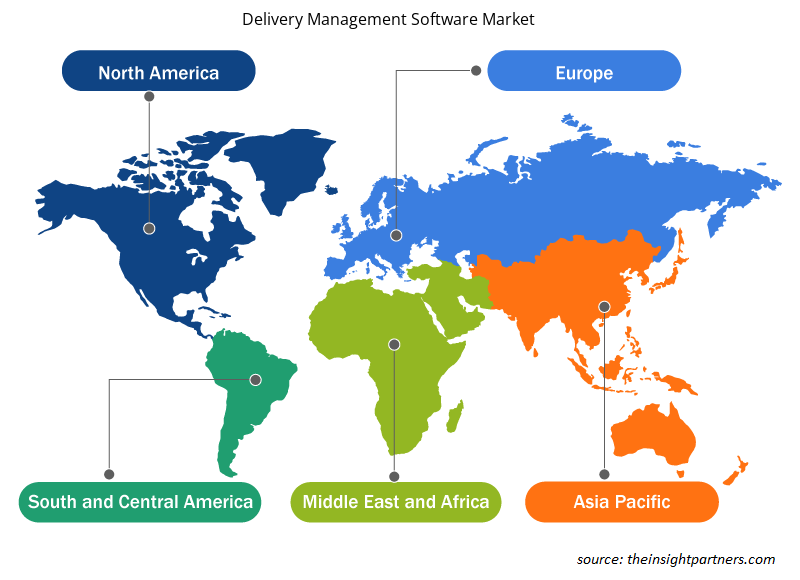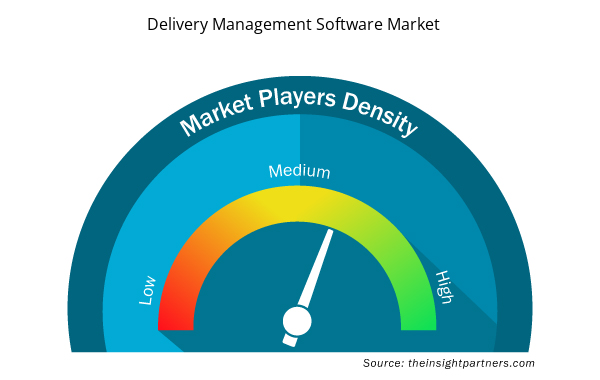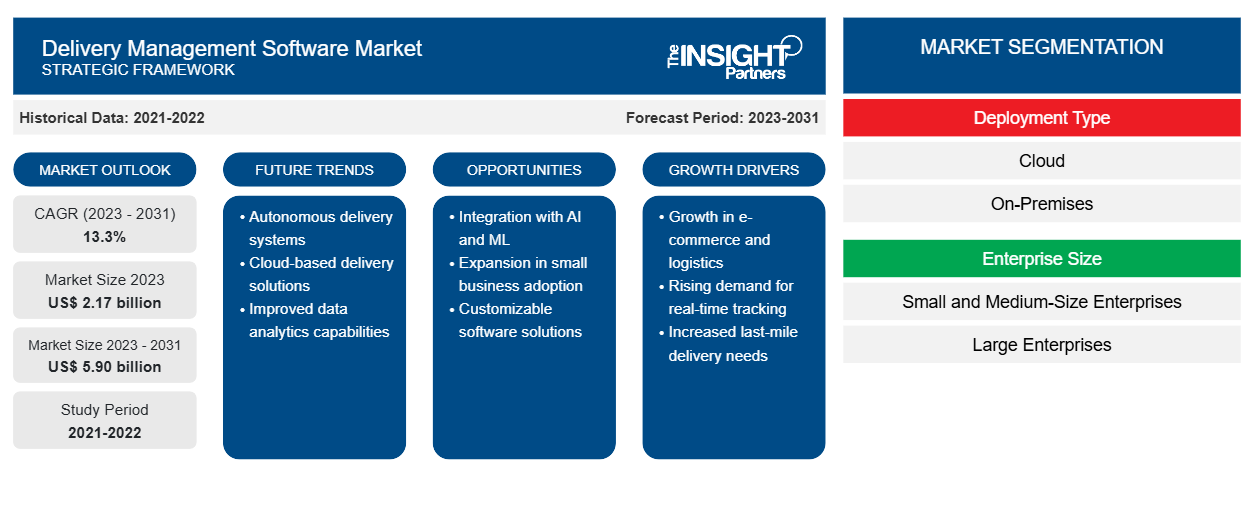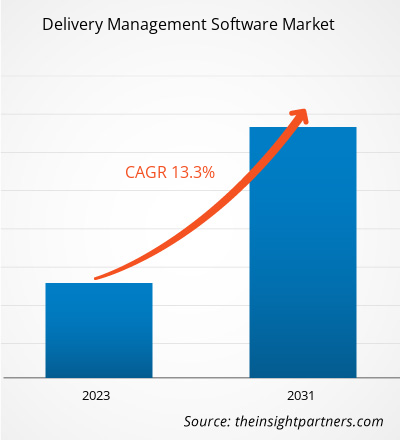من المتوقع أن يصل حجم سوق برامج إدارة التسليم إلى 5.90 مليار دولار أمريكي بحلول عام 2031 من 2.17 مليار دولار أمريكي في عام 2023. ومن المتوقع أن يسجل السوق معدل نمو سنوي مركب بنسبة 13.3٪ من عام 2023 إلى عام 2031.
من المرجح أن يظل دمج تقنيات الذكاء الاصطناعي والتعلم الآلي في برامج إدارة التوصيل لتحسين تجربة المستهلك أحد الاتجاهات الرئيسية في سوق برامج إدارة التوصيل.
تحليل سوق برامج إدارة التوصيل
يشهد سوق برامج إدارة التوصيل نموًا سريعًا بسبب توسع صناعة التجارة الإلكترونية والطلب المتزايد على المعلومات في الوقت الفعلي لإدارة الخدمات اللوجستية وسلاسل التوريد. ويتوسع السوق بشكل مطرد، مدفوعًا بالنمو السكاني وارتفاع الرقمنة وتفضيل المستهلكين للتسوق عبر الإنترنت. علاوة على ذلك، يوفر الطلب المتزايد على الأتمتة من قبل المستخدمين النهائيين فرصًا مربحة لنمو السوق.
نظرة عامة على سوق برامج إدارة التوصيل
تُستخدم برامج إدارة التوصيل لتتبع الشحنات وضمان تسليم العناصر للعملاء في الوقت المناسب. يوفر استخدام برامج إدارة التوصيل المبتكرة فوائد كبيرة للشركات، بما في ذلك زيادة استخدام الأصول وتحسين رضا العملاء وخفض استخدام الوقود. يربط البرنامج سائق التوصيل والمكاتب الخلفية على منصة واحدة ويوفر المعلومات التي يحتاجها السائق لتسليم عنصر ما. إن الطلب المتزايد على المعلومات في الوقت الفعلي وتحسين تتبع التوصيل يعزز السوق.
قم بتخصيص هذا التقرير ليناسب متطلباتك
ستحصل على تخصيص لأي تقرير - مجانًا - بما في ذلك أجزاء من هذا التقرير، أو تحليل على مستوى الدولة، وحزمة بيانات Excel، بالإضافة إلى الاستفادة من العروض والخصومات الرائعة للشركات الناشئة والجامعات
- احصل على أهم اتجاهات السوق الرئيسية لهذا التقرير.ستتضمن هذه العينة المجانية تحليلاً للبيانات، بدءًا من اتجاهات السوق وحتى التقديرات والتوقعات.
محركات وفرص سوق برامج إدارة التوصيل
توسع صناعة التجارة الإلكترونية يقود السوق
إن التوسع في صناعة التجارة الإلكترونية والطلب المتزايد على خدمات التوصيل للميل الأخير بين المستهلكين يغذي السوق. تتوسع أعمال التجارة الإلكترونية بسرعة في جميع أنحاء العالم، حيث يفضل المزيد من المستهلكين التسوق عبر الإنترنت كخيار مناسب. يؤدي هذا إلى زيادة الطلب على خدمات التوصيل بين المستهلكين، وخاصة التوصيل للميل الأخير. يعد التوصيل للميل الأخير جزءًا مهمًا من أعمال التجارة الإلكترونية. يتضمن نقل السلع من المستودع إلى باب منزل العميل. تركز شركات التجارة الإلكترونية على ضمان وصول سلعها إلى العملاء بسرعة وبتكلفة فعالة، مما يزيد من الطلب على برامج إدارة التوصيل بين الشركات. ومع ذلك، فإن التوسع في صناعة التجارة الإلكترونية وتحول تفضيلات المستهلكين نحو التسوق عبر الإنترنت يغذي السوق.
الطلب المتزايد على الأتمتة من قبل المستخدمين النهائيين – فرصة في سوق برامج إدارة التوصيل
إن ظهور التقنيات المتطورة يمثل إمكانات نمو مربحة لسوق برامج إدارة التوصيل. حيث يقوم اللاعبون الكبار في سوق برامج إدارة التوصيل باستثمارات كبيرة في تبني تقنيات الذكاء الاصطناعي والتعلم الآلي لأتمتة عمليات التوصيل الخاصة بهم. علاوة على ذلك، تكتسب الأتمتة زخمًا كبيرًا في إدارة التوصيل من خلال دعم الشركات لتحسين إجراءات تنفيذ الطلبات والتوصيل. تساعد الأتمتة المستخدمين النهائيين، مثل توصيل المطاعم والخدمات اللوجستية وشركات البريد السريع وغيرها، على تبسيط الإجراءات وخفض التكاليف وتحسين تجربة العملاء. يتم اعتماد العديد من تقنيات الأتمتة مثل تحسين المسار وبوابات الخدمة الذاتية والتسليم الآلي بشكل كبير من قبل شركات الخدمات اللوجستية لتسليم المنتجات بشكل أسرع وأكثر فعالية.
تقرير تحليل تجزئة سوق برامج إدارة التوصيل
إن القطاعات الرئيسية التي ساهمت في اشتقاق تحليل سوق برامج إدارة التسليم هي نوع النشر وحجم المؤسسة والمستخدم النهائي.
- بناءً على نوع النشر، ينقسم سوق برامج إدارة التسليم إلى السحابة والمحلية. احتل قطاع السحابة حصة سوقية أكبر في عام 2023.
- من حيث حجم المؤسسة، ينقسم سوق برامج إدارة التسليم إلى شركات صغيرة ومتوسطة الحجم وشركات كبيرة. احتلت شريحة الشركات الكبيرة حصة سوقية أكبر في عام 2023.
- على أساس المستخدم النهائي، يتم تقسيم السوق إلى توصيل المطاعم والخدمات اللوجستية وأعمال البريد السريع وغيرها. احتل قطاع الخدمات اللوجستية الحصة الأكبر من السوق في عام 2023.
تحليل حصة سوق برامج إدارة التوصيل حسب المنطقة الجغرافية
ينقسم النطاق الجغرافي لتقرير سوق برمجيات إدارة التسليم بشكل أساسي إلى خمس مناطق: أمريكا الشمالية، ومنطقة آسيا والمحيط الهادئ، وأوروبا، والشرق الأوسط وأفريقيا، وأمريكا الجنوبية/أمريكا الجنوبية والوسطى.
من حيث الإيرادات، استحوذت منطقة آسيا والمحيط الهادئ على أكبر حصة في سوق برامج إدارة التوصيل، مع توسع قطاع التجارة الإلكترونية، ونمو عدد السكان، وتفضيل المستهلكين للتسوق عبر الإنترنت. إن الطلب المتزايد على برامج إدارة التوصيل بين الشركات لتبسيط عمليات التوصيل من خلال تقليل تكاليف الخدمات اللوجستية الإضافية هو المحرك الرئيسي للسوق. وعلاوة على ذلك، فإن التقدم التكنولوجي والطلب المتزايد على البرامج المستندة إلى السحابة لإدارة توصيل المنتجات بشكل مناسب يخلق فرصًا في السوق.
أخبار سوق برامج إدارة التوصيل والتطورات الأخيرة
يتم تقييم سوق برامج إدارة التوصيل من خلال جمع البيانات النوعية والكمية بعد البحث الأولي والثانوي، والذي يتضمن منشورات الشركات المهمة وبيانات الجمعيات وقواعد البيانات. فيما يلي قائمة بالتطورات في سوق برامج إدارة التوصيل والاستراتيجيات:
- في فبراير 2024، اشترت Inspire Brands برنامج Vromo لتبسيط قنوات التوصيل. Vromo هو برنامج توصيل طعام عبر الإنترنت يدعم Inspire Brands لتشغيل عملية التوصيل من خلال توفير مزايا تتبع التوصيل للعميل النهائي. (المصدر: Inspire Brands، بيان صحفي، 2024)
رؤى إقليمية حول سوق برامج إدارة التوصيل
لقد قام المحللون في Insight Partners بشرح الاتجاهات والعوامل الإقليمية المؤثرة على سوق برامج إدارة التوصيل طوال فترة التوقعات بشكل شامل. يناقش هذا القسم أيضًا قطاعات سوق برامج إدارة التوصيل والجغرافيا في جميع أنحاء أمريكا الشمالية وأوروبا ومنطقة آسيا والمحيط الهادئ والشرق الأوسط وأفريقيا وأمريكا الجنوبية والوسطى.

- احصل على البيانات الإقليمية المحددة لسوق برامج إدارة التوصيل
نطاق تقرير سوق برامج إدارة التوصيل
| سمة التقرير | تفاصيل |
|---|---|
| حجم السوق في عام 2023 | 2.17 مليار دولار أمريكي |
| حجم السوق بحلول عام 2031 | 5.90 مليار دولار أمريكي |
| معدل النمو السنوي المركب العالمي (2023 - 2031) | 13.3% |
| البيانات التاريخية | 2021-2022 |
| فترة التنبؤ | 2023-2031 |
| القطاعات المغطاة | حسب نوع النشر
|
| المناطق والدول المغطاة | أمريكا الشمالية
|
| قادة السوق وملفات تعريف الشركات الرئيسية |
|
كثافة اللاعبين في سوق برامج إدارة التسليم: فهم تأثيرها على ديناميكيات الأعمال
يشهد سوق برامج إدارة التوصيل نموًا سريعًا، مدفوعًا بالطلب المتزايد من المستخدم النهائي بسبب عوامل مثل تفضيلات المستهلكين المتطورة والتقدم التكنولوجي والوعي المتزايد بفوائد المنتج. ومع ارتفاع الطلب، تعمل الشركات على توسيع عروضها والابتكار لتلبية احتياجات المستهلكين والاستفادة من الاتجاهات الناشئة، مما يؤدي إلى زيادة نمو السوق.
تشير كثافة اللاعبين في السوق إلى توزيع الشركات أو المؤسسات العاملة في سوق أو صناعة معينة. وهي تشير إلى عدد المنافسين (اللاعبين في السوق) الموجودين في مساحة سوق معينة نسبة إلى حجمها أو قيمتها السوقية الإجمالية.
الشركات الرئيسية العاملة في سوق برمجيات إدارة التسليم هي:
- شركة ديليفورس للتكنولوجيا الخاصة المحدودة
- فارآي (روبوتيك وارز المحدودة)
- شركة جيت سويفت المحدودة
- أعمال الغابة
- شركة لوجينكست سوليوشنز الخاصة المحدودة
- شركة موبيسوفت انفوتيك المحدودة
إخلاء المسؤولية : الشركات المذكورة أعلاه ليست مرتبة بأي ترتيب معين.

- احصل على نظرة عامة على أهم اللاعبين الرئيسيين في سوق برامج إدارة التسليم
تقرير سوق برامج إدارة التوصيل والتغطية والمنتجات النهائية
يوفر تقرير "حجم سوق برامج إدارة التسليم والتوقعات (2023-2031)" تحليلاً مفصلاً للسوق يغطي المجالات التالية:
- حجم السوق والتوقعات على المستويات العالمية والإقليمية والوطنية لجميع قطاعات السوق الرئيسية التي يغطيها النطاق
- ديناميكيات السوق مثل المحركات والقيود والفرص الرئيسية
- الاتجاهات المستقبلية الرئيسية
- تحليل مفصل لقوى PEST/Porter الخمس وSWOT
- تحليل السوق العالمي والإقليمي الذي يغطي اتجاهات السوق الرئيسية واللاعبين الرئيسيين واللوائح والتطورات الأخيرة في السوق
- تحليل المشهد الصناعي والمنافسة الذي يغطي تركيز السوق، وتحليل خريطة الحرارة، واللاعبين البارزين، والتطورات الأخيرة
- ملفات تعريف الشركة التفصيلية
- التحليل التاريخي (سنتان)، السنة الأساسية، التوقعات (7 سنوات) مع معدل النمو السنوي المركب
- تحليل PEST و SWOT
- حجم السوق والقيمة / الحجم - عالميًا وإقليميًا وقطريًا
- الصناعة والمنافسة
- مجموعة بيانات Excel


- Industrial Inkjet Printers Market
- Smart Grid Sensors Market
- Radiopharmaceuticals Market
- Adaptive Traffic Control System Market
- Medical and Research Grade Collagen Market
- Architecture Software Market
- Excimer & Femtosecond Ophthalmic Lasers Market
- Cut Flowers Market
- Vertical Farming Crops Market
- Real-Time Location Systems Market

Report Coverage
Revenue forecast, Company Analysis, Industry landscape, Growth factors, and Trends

Segment Covered
This text is related
to segments covered.

Regional Scope
North America, Europe, Asia Pacific, Middle East & Africa, South & Central America

Country Scope
This text is related
to country scope.
الأسئلة الشائعة
The key players holding majority shares in the global delivery management software market are Deliforce Technologies Private Limited, FarEye (RoboticWares Pvt Ltd), GetSwift Limited, Jungleworks, and Loginext Solutions Private Limited.
The incremental growth expected to be recorded for the global delivery management software market during the forecast period is US$ 3.73 billion.
The global delivery management software market is expected to reach US$ 5.90 billion by 2031.
The global delivery management software market was estimated to be US$ 2.17 billion in 2023 and is expected to grow at a CAGR of 13.3% during the forecast period 2023 - 2031.
The expanding e-commerce industry and growing demand for real-time information for managing logistics and supply chains are the major factors that propel the global delivery management software market.
Integration of AI and ML technologies in the delivery management software for enhancing consumer experience is anticipated to play a significant role in the global delivery management software market in the coming years.
Trends and growth analysis reports related to Technology, Media and Telecommunications : READ MORE..
- Deliforce Technologies Private Limited
- FarEye (RoboticWares Pvt Ltd)
- GetSwift Limited
- Jungleworks
- Loginext Solutions Private Limited
- Mobisoft Infotech LLC
- Shipox Inc
- WorkWave LLC
- Zippykind (Snappylead LLC)
- Onro, Inc.
The Insight Partners performs research in 4 major stages: Data Collection & Secondary Research, Primary Research, Data Analysis and Data Triangulation & Final Review.
- Data Collection and Secondary Research:
As a market research and consulting firm operating from a decade, we have published and advised several client across the globe. First step for any study will start with an assessment of currently available data and insights from existing reports. Further, historical and current market information is collected from Investor Presentations, Annual Reports, SEC Filings, etc., and other information related to company’s performance and market positioning are gathered from Paid Databases (Factiva, Hoovers, and Reuters) and various other publications available in public domain.
Several associations trade associates, technical forums, institutes, societies and organization are accessed to gain technical as well as market related insights through their publications such as research papers, blogs and press releases related to the studies are referred to get cues about the market. Further, white papers, journals, magazines, and other news articles published in last 3 years are scrutinized and analyzed to understand the current market trends.
- Primary Research:
The primarily interview analysis comprise of data obtained from industry participants interview and answers to survey questions gathered by in-house primary team.
For primary research, interviews are conducted with industry experts/CEOs/Marketing Managers/VPs/Subject Matter Experts from both demand and supply side to get a 360-degree view of the market. The primary team conducts several interviews based on the complexity of the markets to understand the various market trends and dynamics which makes research more credible and precise.
A typical research interview fulfils the following functions:
- Provides first-hand information on the market size, market trends, growth trends, competitive landscape, and outlook
- Validates and strengthens in-house secondary research findings
- Develops the analysis team’s expertise and market understanding
Primary research involves email interactions and telephone interviews for each market, category, segment, and sub-segment across geographies. The participants who typically take part in such a process include, but are not limited to:
- Industry participants: VPs, business development managers, market intelligence managers and national sales managers
- Outside experts: Valuation experts, research analysts and key opinion leaders specializing in the electronics and semiconductor industry.
Below is the breakup of our primary respondents by company, designation, and region:

Once we receive the confirmation from primary research sources or primary respondents, we finalize the base year market estimation and forecast the data as per the macroeconomic and microeconomic factors assessed during data collection.
- Data Analysis:
Once data is validated through both secondary as well as primary respondents, we finalize the market estimations by hypothesis formulation and factor analysis at regional and country level.
- Macro-Economic Factor Analysis:
We analyse macroeconomic indicators such the gross domestic product (GDP), increase in the demand for goods and services across industries, technological advancement, regional economic growth, governmental policies, the influence of COVID-19, PEST analysis, and other aspects. This analysis aids in setting benchmarks for various nations/regions and approximating market splits. Additionally, the general trend of the aforementioned components aid in determining the market's development possibilities.
- Country Level Data:
Various factors that are especially aligned to the country are taken into account to determine the market size for a certain area and country, including the presence of vendors, such as headquarters and offices, the country's GDP, demand patterns, and industry growth. To comprehend the market dynamics for the nation, a number of growth variables, inhibitors, application areas, and current market trends are researched. The aforementioned elements aid in determining the country's overall market's growth potential.
- Company Profile:
The “Table of Contents” is formulated by listing and analyzing more than 25 - 30 companies operating in the market ecosystem across geographies. However, we profile only 10 companies as a standard practice in our syndicate reports. These 10 companies comprise leading, emerging, and regional players. Nonetheless, our analysis is not restricted to the 10 listed companies, we also analyze other companies present in the market to develop a holistic view and understand the prevailing trends. The “Company Profiles” section in the report covers key facts, business description, products & services, financial information, SWOT analysis, and key developments. The financial information presented is extracted from the annual reports and official documents of the publicly listed companies. Upon collecting the information for the sections of respective companies, we verify them via various primary sources and then compile the data in respective company profiles. The company level information helps us in deriving the base number as well as in forecasting the market size.
- Developing Base Number:
Aggregation of sales statistics (2020-2022) and macro-economic factor, and other secondary and primary research insights are utilized to arrive at base number and related market shares for 2022. The data gaps are identified in this step and relevant market data is analyzed, collected from paid primary interviews or databases. On finalizing the base year market size, forecasts are developed on the basis of macro-economic, industry and market growth factors and company level analysis.
- Data Triangulation and Final Review:
The market findings and base year market size calculations are validated from supply as well as demand side. Demand side validations are based on macro-economic factor analysis and benchmarks for respective regions and countries. In case of supply side validations, revenues of major companies are estimated (in case not available) based on industry benchmark, approximate number of employees, product portfolio, and primary interviews revenues are gathered. Further revenue from target product/service segment is assessed to avoid overshooting of market statistics. In case of heavy deviations between supply and demand side values, all thes steps are repeated to achieve synchronization.
We follow an iterative model, wherein we share our research findings with Subject Matter Experts (SME’s) and Key Opinion Leaders (KOLs) until consensus view of the market is not formulated – this model negates any drastic deviation in the opinions of experts. Only validated and universally acceptable research findings are quoted in our reports.
We have important check points that we use to validate our research findings – which we call – data triangulation, where we validate the information, we generate from secondary sources with primary interviews and then we re-validate with our internal data bases and Subject matter experts. This comprehensive model enables us to deliver high quality, reliable data in shortest possible time.


 احصل على عينة مجانية لهذا التقرير
احصل على عينة مجانية لهذا التقرير